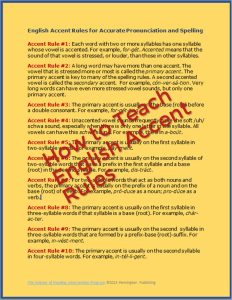Ten English Accent Rules

How to Teach English Accent Rules
Regarding syllable accent rules, most teachers are unfamiliar with the the ten English accent rules and the role that these rules play in orthography (the study of spelling rules). The accent is the stress placed in varying degrees upon the vowel sounds in syllables. The primary accent refers to the vowel sound with the greatest “punch” or “stress.” A good way to teach accents is to have students clap on the accented syllable and snap on the unaccented syllables. Teachers may choose to add on secondary accents; however, these have minimal influences on pronunciation and spelling. Check out How to Teach Syllabication after you skim through this helpful list of accent rules. The Ten English Accent Rules are important to understand and apply to be able to correctly pronounce and spell English words.
Accent Rule #1: Each word with two or more syllables has one syllable whose vowel is accented. For example, for-gét. Accents are very important to spelling rules. Accented means that the sound of that vowel is stressed, or louder, than those in other syllables.
Accent Rule #2: A long word may have more than one accent. The vowel that is stressed more or most is called the primary accent. The primary accent is key to many of the spelling rules. A second accented vowel is called the secondary accent. For example, cón-ver-sá-tion. Very long words can have even more stressed vowel sounds, but only one primary accent.
Accent Rule #3: The primary accent is usually on the root before a double consonant. For example, for-gét-ting.
Accent Rule #4: Unaccented vowel sounds frequently have the soft /uh/ schwa sound, especially when there is only one letter in the syllable. All vowels can have the schwa sound. For example, the a in a-boút.
Accent Rule #5: The primary accent is usually on the first syllable in two-syllable words. For example, páy-ment.
Accent Rule #6: The primary accent is usually on the second syllable of two-syllable words that have a prefix in the first syllable and a root in the second syllable. For example, dis-tráct.
Accent Rule #7: For two-syllable words that act as both nouns and verbs, the primary accent is usually on the prefix (first syllable) of the noun and on the root (second syllable) of the verb. For example, pró-duce as a noun; pro-dúce as a verb.
Accent Rule #8: The primary accent is usually on the first syllable in three-syllable words, if that syllable is a root. For example, chár-ac-ter.
Accent Rule #9: The primary accent is usually on the second syllable in three-syllable words that are formed by a prefix-root-suffix. For example, in-vést-ment.
Accent Rule #10: The primary accent is usually on the second syllable in four-syllable words. For example, in-tél-li-gent.
Interested in how to introduce and practice these syllable accent rules with your students? Check out the related article, “How to Teach English Accent Rules.”
Get the Accent Rules FREE Resource:
![]()
*****

The Science of Reading Intervention Program
The Science of Reading Intervention Program: Word Recognition includes explicit, scripted, sounds to print instruction and practice with the 6 Daily Google Slide Activities every grades 4-adult reading intervention student needs: 1. Phonemic Awareness 2. Blending, Segmenting, and Spelling 3. Sounds and Spellings (including handwriting) 4. Heart Words Practice 5. Sam and Friends Phonics Books (decodables). Plus, 6. Digital and printable sound wall cards, speech articulation songs, Elkonin sound box dictations, sounds to print games, and multi-syllabic decoding. Print versions are available for all activities. First Half of the Year Program (55 minutes-per-day, 18 weeks)
The Science of Reading Intervention Program: Language Comprehension resources are designed for students who have completed the word recognition program or have demonstrated basic mastery of the alphabetic code and can read with some degree of fluency. The program features the 5 Weekly Language Comprehension Activities: 1. Background Knowledge Mentor Texts 2. Academic Language, Greek and Latin Morphology, Figures of Speech, Connotations, Multiple Meaning Words 3. Syntax in Reading 4. Reading Comprehension Strategies 5. Literacy Knowledge (Narrative and Expository). Second Half of the Year Program (30 minutes-per-day, 18 weeks)
The Science of Reading Intervention Program: Assessment-based Instruction provides diagnostically-based “second chance” instructional resources. The program includes 13 comprehensive assessments and matching instructional resources to fill in the yet-to-be-mastered gaps in phonemic awareness, alphabetic awareness, phonics, fluency (with YouTube modeled readings), Heart Words and Phonics Games, spelling patterns, grammar, usage, and mechanics, syllabication and morphology, executive function shills. Second Half of the Year Program (25 minutes-per-day, 18 weeks)
The Science of Reading Intervention Program BUNDLE includes all 3 program components for the comprehensive, state-of-the-art (and science) grades 4-adult full-year program. Scripted, easy-to-teach, no prep, no need for time-consuming (albeit valuable) LETRS training or O-G certification… Learn as you teach and get results NOW for your students. Print to speech with plenty of speech to print instructional components.
Click the SCIENCE OF READING INTERVENTION PROGRAM RESOURCES for detailed program description, sample lessons, and video overviews. Click the links to get these ready-to-use resources, developed by a teacher (Mark Pennington, MA reading specialist) for teachers and their students.
Get the SCRIP Comprehension Cues FREE Resource:
![]()
Get the Diagnostic ELA and Reading Assessments FREE Resource:![]()
*****